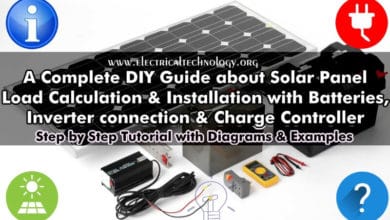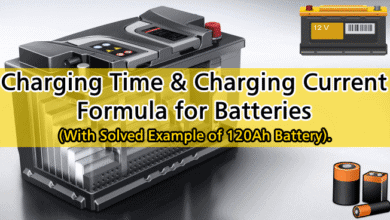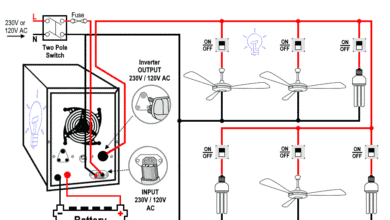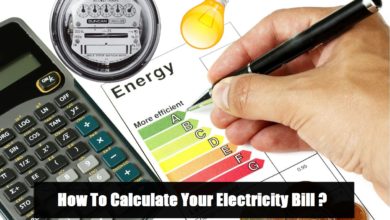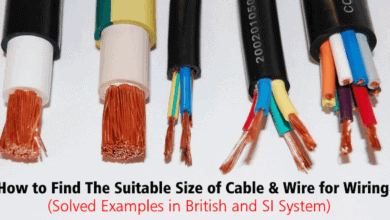Grounding and Methods of Earthing in PV Solar System
Methods of Earthing and Grounding in PV Solar Panel Systems
Grounding (also known as earthing) is the process of physically connecting the metallic and exposed parts of a device to the earth. It is a mandatory practice required by NEC and IEC codes to protect both equipment and personnel from damage and electric shock hazards. This article covers grounding in PV systems, which differs slightly from standard grounding systems.
The concept and purpose of grounding in DC systems, such as solar panels and photovoltaic arrays, are the same as in AC systems. However, the grounding process and methods differ slightly, offering multiple options, such as separate grounding or combined grounding.
Single vs Multiple Ground Rod in Solar PV System
In an ideal grounding system, there should be only one path to the earth for fault current to flow during faults, while every metallic part of the electrical system should be properly bonded together.
When multiple ground rods are used, there is a risk of creating grounding loops, which can cause serious issues, especially during lightning strikes and transient voltage events. These grounding loops (additional paths created by multiple ground rods) can interfere with the proper functioning of GFCI/AFCI devices. Similarly, high transient voltage and lightning strikes may damage interconnected equipment.
For this reason, a single grounding conductor is recommended for a premises. If auxiliary grounding electrodes are required by design, they must be spaced at least 6 feet (1.83 meters) apart and must not be less than 2.44 meters (8 feet) in length, as specified in NEC Sections 250.52(A)(5), 250.53(A)(2), 250.53(A)(4), and 250.53(C).
If separate grounding systems and grounding electrode conductors (GECs) are installed in a structure or different buildings, they should be combined at a common point (busbar or terminal) and connected to the common grounding electrode system.
The main bonding jumper (MBJ) and grounding electrode conductor (GEC) should be connected at the same point. This can be the grounding busbar terminal inside the main disconnect, main panel, or load center. Connecting the neutral to the equipment grounding conductor (EGC) at multiple points will create multiple grounding loops and cause objectionable current to flow in the circuit.
This small current can flow back to the source through the grounding conductor (EGC) or the body of equipment during normal circuit operation. This fault current may interfere with the proper function of GFCI/AFCI devices even when no actual fault is present in the circuit.
One or more auxiliary grounding electrodes are permitted to be connected to the EGC as specified in NEC 250.118. This configuration is not required to comply with the electrode bonding requirements of 250.50, 250.53(C), or the resistance requirements of 250.53(A)(2). This applies only when the earth is not being used as an effective ground-fault current path, as specified in 250.4(A)(5) and 250.4(B)(4).
According to 250.54, while auxiliary grounding electrodes are permitted, they are not required to be connected to the building or structure grounding electrode system. Similarly, supplementary electrodes are not required to have an earth resistance of 25 ohms or less.
An auxiliary electrode is not required, and if installed, it does not need to be connected to the building grounding electrode system. The grounding electrode conductor is not required to be of a specific size, nor does it need to have a maximum contact resistance (per NEC 600.7(A)(4)).
If a supplemental electrode is used for an array, the metal structure or metal frame of roof-mounted or pole-mounted PV arrays can serve as the grounding electrode, provided it complies with 250.52 and 250.53(A)(2). Additionally, an extra array grounding electrode is not required if the array is located within 6 feet of the building’s wire electrode (per 690.47(B)).
- Related Post: Difference Between AC Ground and DC Ground?
Grounding and Earthing Methods for PV Systems
The National Electrical Code (NEC) Sections 690.41 and 690.47(C)(3) allow combined AC and DC grounding and bonding based on system design and requirements, in accordance with NEC Article 250. However, there are multiple methods for grounding DC systems in PV arrays. The recommended approach is to use a separate DC grounding electrode for PV arrays and frames, as this enhances protection against lightning and transient voltage. For lightning protection associated with grounding systems, refer to NFPA 780 and NEC 250.106.
Similarly, IEC 60364, IEC 62305-3, and BS 7430 recommend connecting lightning arresters used for PV arrays to the main grounding system. On the other hand, IEEE 1100-2003, IEC 1100-2005, and IEC 61000-5-2 advocate for dedicated and isolated earthing for DC and electronic equipment.
Modern grounded inverters and PV arrays are not isolated from the grounded output circuit of the inverter. In this scenario, the equipment grounding conductor (EGC) of the PV circuit can be connected to the grounding terminal of the inverter, which is eventually connected to the AC grounding system and electrode within the premises. Hence, this practice eliminates the need for a separate DC grounding system for the PV system.
Below are the three grounding configurations (based on NEC) commonly used in a typical PV solar system.
Separate AC & DC Grounding Electrodes
As shown in the fig, separate grounding rods are used for individual systems e.g. AC side and DC side. The equipment grounding conductor (EGC) from the main panel and PV arrays are connected to the Ground terminal and Ground bus in the inverter. Both grounding electrode conductors (GEC) are connected to the individual grounding rod used for both systems. Meanwhile, both ground electrodes (AC ground rod and DC ground rod) are bonded through a bonding jumper as required by NEC.
AC & DC Grounding through Single Ground Rod
The following fig shows an alternative way of grounding AC and DC in PV systems. The inverter is connected to the single ground rod used for both AC and DC using the GEC. While the PV array and inverter is connected to the main grounding terminal in the main panel through he EGC.
Combine AC & DC Grounding in PV System
In this grounding method, a single copper ground rod is used for both AC system and DC solar panel system using combined DC GEC and AC EGC. As shown, the PV arrays is connected to the ground bus in inverter via EGC. The AC EGC is connected from the main panel to the inverter ground terminal.
- Related Post: Difference Between Grounding, Earthing and Bonding
AC & DC Grounding in Solar Panels Installations
The frames of PV/solar panels can be connected to the DC ground busbar. This is because, in most cases, the ground rods for both AC and DC are bonded together through the inverter. Since non-isolated DC-to-DC chargers are already connected to ground-to-neutral via the bonding wire, you should remove the bonding between the ground and neutral busbar when using a non-isolated DC-to-DC charger.
Off-Grid System Grounding
Since the -Ve input of the MPPT (from the PV array) is non-isolated from the -Ve output of the MPPT, grounding the PV array can cause ground loops and circulating currents. Therefore, it is not recommended to ground the +Ve or -Ve of the PV array. However, the frames of the PV array must be grounded to protect against lightning and transient voltages.
Although battery terminals are generally safe to touch (e.g. 12V car battery), the chassis of the inverter and MPPT solar charger must be grounded for safety.
Stationary Off-Grid System Grounding
In a stationary off-grid system, a separate DC grounding system should be used for the charger, batteries, and inverter input, independent of the household AC grounding system, to avoid interference. However, the frames of the PV array can be connected directly to the nearest ground rod in the AC ground system without requiring an additional ground rod. Placing an extra ground rod can create ground loops and increase the risk of device damage during lightning strikes.
Mobile Off-Grid System Grounding
In a mobile off-grid system (such as an RV, camper, or boat), no ground rod is used. Instead, the frames of the PV panels, battery, and charger can be directly connected to the chassis of the vehicle. An additional grounding wire is unnecessary if the resistance of the setup is close to zero ohms, reducing costs and eliminating ground loops
Off-Grid with Generator
For proper operation of GFCI, RCD, RCCB, or RCBO during ground faults, use a single ground point located near the battery. In high-power generators, ground protection should be provided at the main grounding system.
Ensure that cables and wires (both AC and DC) are sized according to the fuse/circuit breaker rating and can handle fault currents safely.
If no ground fault protection devices are used, it is safer to remove the AC neutral-to-chassis connection. Alternatively, you may establish a neutral-to-ground connection (only if permitted by local electrical codes).
ON-Grid Energy Storage System (ESS)
In a grid-connected energy storage system (ESS), the chassis of the inverter or solar charger should be connected to the central ground busbar (AC-out ground terminal).
- Related Post: Will I Get an Electric Shock If I Touch the Ground Wire?
NEC Requirements for AC & DC Grounding in PV System
All exposed metal surfaces and equipment likely to become energized must be bonded and connected to the equipment grounding conductor (EGC). The bonding method and type of EGC can vary. It may be a wire-type conductor, intermediate metal conduit, electrical metal tubing, rigid metal conduit, or part of a metal-clad cable. The selection depends on system requirements and must comply with NEC 250.118.
In grounding electrode systems where a DC electrode is bonded to an AC electrode, a separate DC grounding electrode must be bonded to the AC grounding electrode system. This is done using a bonding jumper. The jumper size must be based on the larger of the existing AC grounding electrode conductor (GEC) or DC GEC, as specified in 250.166 (690.47(C)(1)).
In a common DC-AC grounding electrode system, a DC grounding electrode conductor, sized per 250.166, can be run from the marked DC grounding electrode connection point to the AC grounding electrode when accessible (690.47(C)(2)).
Where an AC grounding electrode is not accessible, the DC grounding electrode conductor is permitted to terminate at the AC grounding electrode conductor using a connector listed for grounding and bonding (690.47(C)(2)).
For grounding electrode conductors used in combined AC EGC and DC GEC for grounded PV systems, the AC equipment grounding conductor, sized according to the larger of 250.122 or 250.166, can serve as the DC grounding electrode conductor (690.47(C)(3)).
A DC grounding electrode conductor from the array structure, sized in accordance with 250.166, must be connected to a grounding electrode that complies with 250.52 and 250.54 (690.47(D)).
The lightning protection system electrode cannot be used as the required building or structure grounding electrode system (250.60). Hence, the building grounding electrode system should be separate from the lightning protection electrode and strike termination devices.
The installation of solar PV systems for residential and commercial applications should comply with 690.41, 690.42, 690.43, 690.45, and 690.47, in conjunction with NEC 240 (for protection devices) and NEC 250 (for grounding and bonding).
Grounding electrodes should be properly selected and buried below the moisture level in accordance with NEC 250.50 and 250.52.
Sizing of Grounding Conductors (GEC & EGC)
AC Grounding Electrode Conductor (GEC):
The size of the AC GEC can be determined using NEC 250.66 and Table 250.66. The minimum GEC size must match the largest ungrounded current-carrying conductor in the wiring installation. The GEC must be protected in metal conduit, intermediate metal conduit, or PVC conduit if exposed to physical damage or if the GEC is smaller than 6 AWG. Additionally, splicing the GEC is not allowed except through NEC-permitted methods.
Equipment Grounding Conductor (EGC):
The size of the EGC can be determined using NEC 250.122 and Table 250.122. The EGC size is based on the overcurrent protection device (OCPD) used for PV circuits when leaving the vicinity of the PV array. An EGC must run within the same circuit or raceway as the current-carrying conductors. If the EGC is smaller than 6 AWG, it must be installed in cable armor or a raceway to protect it from physical damage.
Ground-Fault Protection for PV Circuits
PV circuits operating at 30 volts or 8 amps must be protected using a ground-fault protection device (GFPD). Almost all modern inverters include built-in GFPD protection. A GFPD-protected and UL 1741-listed inverter disconnects output power and isolates the faulted circuit from the rest of the system during a fault condition.
A GFPD is not required for a PV circuit if:
- The PV circuit is not installed on a building.
- The PV system is directly grounded.
- No more than two PV circuits are connected in parallel.
- All metallic parts, equipment, and supporting structures in the PV system must be bonded and grounded.
- The EGC and GEC conductors used for AC and DC grounding must be sized and installed according to NEC 250.104, 250.122 (Table 250.122), 250.134, 250.136, and 250.66 (Table 250.66).
- The DC grounding conductor (sometimes called a bonding conductor) must be continuous and properly sized to handle fault currents.
- All equipment used to support or mount PV modules must be bonded through the EGC. The grounding system must be labeled, listed, and identified in accordance with UL 2703.
- Lightning protection and surge protection devices (SPDs) for PV array structures should be installed in accordance with NEC 250.106 and NFPA 780.
Resources:
- Why is the Grounding Wire Bare and Not Insulated?
- Why is the Ground Wire Size Smaller than the Hot Wire?
- Why is the Ground Wire Always Positioned Above the Overhead Power Lines?
- Why Must Neutral and Ground Wires Be Bonded in the Main Panel?
- Why are Neutral and Ground Wires Separated in a Subpanel?
- Will a Man Get an Electric Shock If He Hangs on a Live Wire?
- Why are Salt and Charcoal Added in Earthing Pit for Grounding?
- Can the Neutral Wire Cause Electric Shock?
- What Happens When You Touch an Electrical Busbar?
- Why Do The Positive And Negative Wires Spark When Touched?
- Difference Between GND, 0VDC, Common and Virtual Ground
- Is It Possible to Get Electrocuted by an Electric Vehicle?
- How Does the Grounding System Work in Aircraft & Submarines?
- How to Size the Earth Conductor, Earthing Lead & Earth Electrodes?
- Difference Between Neutral, Ground and Earth?
- Design of Grounding / Earthing System in a Substation Grid



